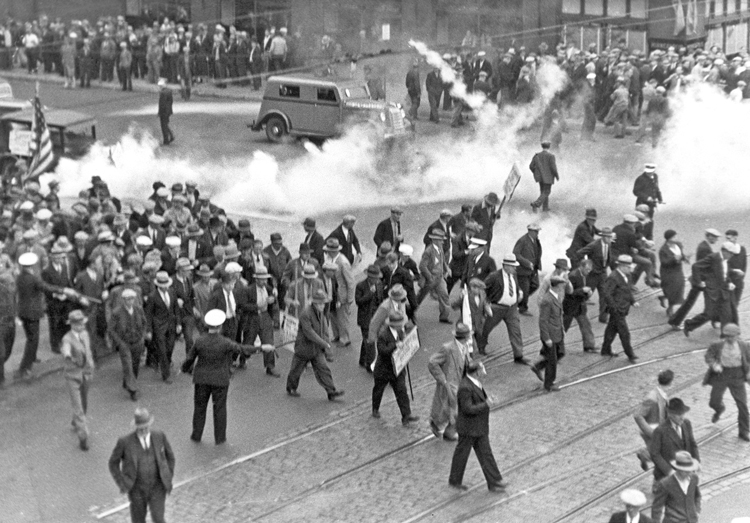Teamster Rebellion by Farrell Dobbs is one of Pathfinder’s Books of the Month for July. It is the story of the Teamsters’ organizing drive in Minneapolis where rank-and-file workers won hard-fought strikes in 1934, defeating combined strikebreaking efforts by the trucking bosses, the employers’ Citizens Alliance and the city, state and federal governments. Dobbs was a young worker who became part of the class-struggle union leadership and then a leader of the Socialist Workers Party. He describes how a fighting industrial union movement was built there, helping pave the way for the rise of the CIO during the Great Depression. The excerpt below is from chapter 4, “The opening wedge.” Copyright © 2004 by Pathfinder Press. Reprinted by permission.
Wiseacres of the day spoke pontifically about the “passivity” of the working class, never understanding that the seeming docility of the workers at a given time is a relative thing. If workers are more or less holding their own in daily life and expecting that they can get ahead slowly, they won’t tend to radicalize. Things are different when they are losing ground and the future looks precarious to them. Then a change begins to occur in their attitude, which is not always immediately apparent. The tinder of discontent begins to pile up. Any spark can light it, and once lit, the fire can spread rapidly.
In Minneapolis the flames were bound to become widespread because it was not only the coal workers who were being driven toward action to correct an increasingly intolerable situation. Conditions were bad throughout the entire trucking industry. Wages were as low as ten dollars and rarely above eighteen dollars for a workweek ranging from fifty-four to ninety hours. …
Another objective factor impinging upon the Minneapolis scene was the general working-class upsurge then beginning to take place throughout the country. Seeking help from the official labor movement to defend their class interests, workers were pouring into the AFL in growing numbers. During 1933 a mounting wave of strikes developed nationally. This trend arose primarily because of low pay, long hours and a general feeling of insecurity. It got further impetus from one aspect of Roosevelt’s “New Deal” which had been in operation since the spring of the year. Section 7(a) of the newly adopted National Industrial Recovery Act (NRA) purportedly guaranteed the workers the “right to organize.” This official declaration helped along the process of unionization, even though the workers were to find themselves mistaken in their belief that the capitalist government would actually protect their rights. …
A problem resulted for the insurgent workers, especially the younger militants who spearheaded the radicalization. Their youthfulness freed them from the inhibiting effects of earlier labor defeats and they moved toward battle with the bosses as though they were inventing something new. It followed, however, that they were inexperienced and didn’t know just how to conduct the fight. This made them vulnerable to AFL misleaders trained in the Gompers school. A saving factor existed in the workers’ objective need to find leaders with a correct policy and the fighting ability to carry it out. To meet this need, the help of a revolutionary socialist party was required. …
Holding an official post does not automatically make one a leader. A semblance of leadership authority can be maintained for a time through bureaucratic abuse of official powers, but in the long run one must actually meet the responsibilities of a given post or a leadership void will be created. In the latter case someone else can step into the void and begin to exercise actual leadership authority without necessarily holding an official post. A contradictory situation develops, the outcome of which has to be determined by the course of events. In the end the more competent leader, as proven through performance, can wind up with the official authority as well.
It follows that the ultimate gaining of such official authority marks the end of what has been a war on two fronts. The central object all along will have been to lead an effective struggle against the employers. …
These formations are not as wholly monolithic as might appear at first sight. The most hidebound component is at the very top. Under that top crust there are layers of lesser officials who are closer to the union ranks and more subject to influence by the workers. Although these lesser officials are under pressure from the top to act as police against the union ranks, they are sometimes disinclined to do so when the workers are up in arms against the employers. …
A broad strike committee was organized to assume command of the picketing. Before the walkout began, mimeographed picketing instructions were prepared, along with maps showing the location of all coal yards.
The strike hit the industry with a bang. Characterized by militant mass picketing from the outset, the whole operation was both audacious and efficient. The pickets, mainly young workers in their first labor struggle, reinforced the careful planning by experienced leaders with courageous actions during which they came up with some innovations of their own. Development and use of cruising picket squads was an outstanding example of the rank-and-file ingenuity. …
The whirlwind action had indeed caught the bosses unprepared. They were put in a further bind by the frigid cold wave that accompanied the walkout and led to stiff public pressure for fuel deliveries. With the yards tied up tight, the employers had to make a settlement which brought the workers limited material gains. Most importantly, however, they had been compelled to recognize the union. …
For the first time in many years a strike had been won in Minneapolis. Electrified by the victory, union members throughout the city gained self-confidence and thousands of unorganized workers lifted their eyes toward the union movement with a new sense of hope. The stage was now set for the main conflict, and both sides began to gird for the showdown that was soon to begin.


